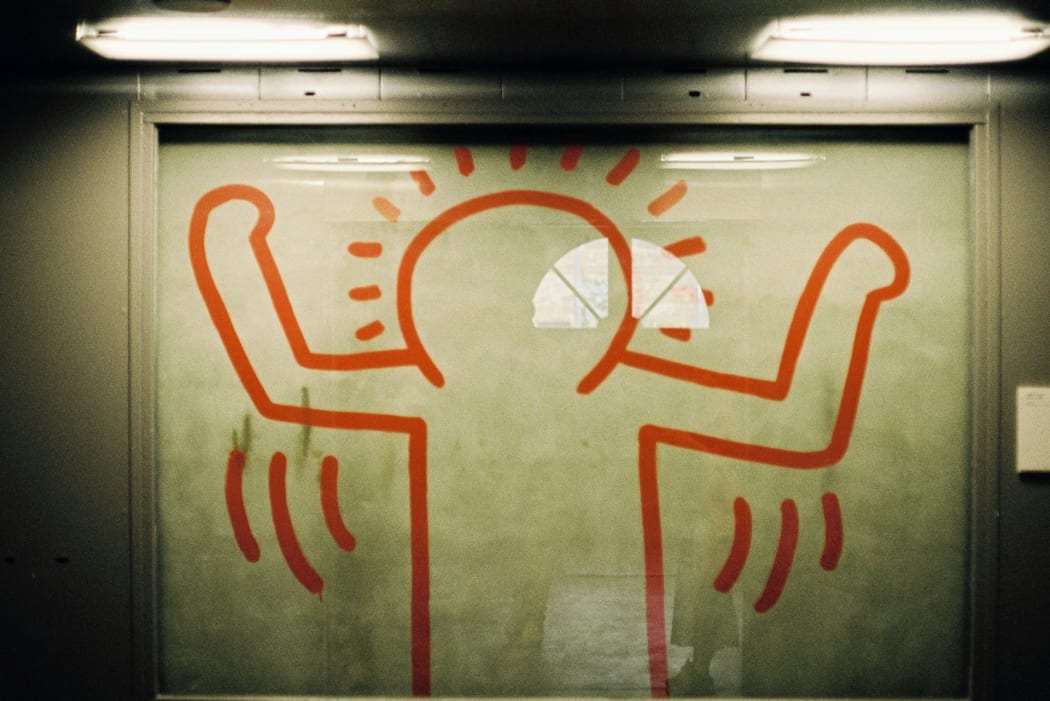
Whether created using markers, chalk, felt-tip pens, ink, acrylic or spray paint, Haring’s line remained an ever flowing constant - a testament to his well-honed and refined technical skill as much as to his endless energy and creativity. Befitting an artist commonly associated with street art, Haring used a wide range of different mediums which allowed him to explore form, scale and messaging.
Mostly commonly associated with Haring, Tarpaulin proved to be a medium to which Haring would return throughout his career. Haring began using vinyl or muslin tarpaulin (“tarp”) as a surface circa 1981-1982 about the same time, he began his famous Subway Drawings. It is rumoured that Haring first took notice of tarp as a possible medium when living in his Broome Street apartment where he would see huge construction projects transforming the Lower East Side and subsequent, intended, use of the material. Influenced by the expanding field of art in the early ‘80s and the idea of non-convention, Haring enthusiastically embraced this populist conception of and chose tarpaulin as a way of carrying this “alternative” pop sensibility into important ‘80s galleries like Leo Castelli and Tony Shafrazi. Unlike traditional canvases, the tarps are not stretched but hung via grommets sewn into the fabric of the painted surface, providing for a continuous expanse of canvas on a monumental scale while retaining the popular dimension so important to Haring.
Marker on Terracotta Vases https://www.haring.com/!/art-work/185
In the early 1980s, New York City's streets became a vibrant playground for alternative artists and performers. Inspired by the subversive culture around them and building on the legacy of the ‘60s and ‘70s, hip-hop musicians, breakdancers, and graffiti artists left an indelible mark on the city’s rich history.
Graffiti culture, in particular, flourished in New York's subways and streets despite the city’s expensive efforts since the ‘70s to combat vandalism. Graffiti "tags" became a common sight throughout the Big Apple, as artists competed to leave their signatures in as many places as possible while evading the police.
Among the most recognizable tags of 1980 was LA2 (LAROC, LAII), created by a young Puerto Rican artist who started tagging in junior high, using markers on books, walls, and tables. The artist behind the name was 13-year-old Angel Ortiz, a native of the Lower East Side. Catching the eye of Haring, LA2 would later collaborate with Haring on and off throughout the decade. Wth a distinctive, interlocking tag that Haring likened to almost calligraphy or Arabic lettering, the duo’s wokr would later be displayed in prestigious collections worldwide and even MOMA in New York. One of the most interesting of mediums used in their collaborations was marker on Terracotta vases, Haring explains:
"I began by visiting a workshop on the outskirts of Milan where they produce terracotta pieces. I chose several vases of different sizes and shapes and began the next day to systematically sand, wash, and then embellish the surface with marking ink. The largest of these was big enough for me to stand inside of. There were several small vases which I was attracted to because of their similarity to the shape of nuclear cooling towers. The confrontation between the history of vase paintings and the contemporary approach of drawing with marker and the mixture of contemporary and ancient symbols produces an ironic mixture of opposites." –Keith Haring
Cars as Canvases
In addition to his mural, prints, posters and pop merchandise, Haring continued to explore alternatives mediums as a way to connect with the public. Indeed, throughout the later half of the 1980's, and with his popularity at its height, Haring painted a number of automobiles including BMWs, Land Rovers and Mini Ferrari 330 P-2. The latter produced during at artist residencies at Montreux jazz festival and 24 Hours of Le Mans, and at promotional events for the Fast Art Gallery in New Jersey and Galerie Hans Mayer in Düsseldorf.
Discover Keith Haring art for sale and to buy Keith Haring prints, contact sales@andipa.com or call +44 (0)20 7581 1244.